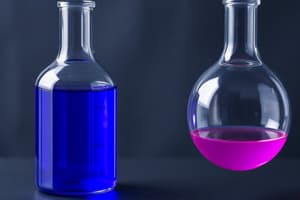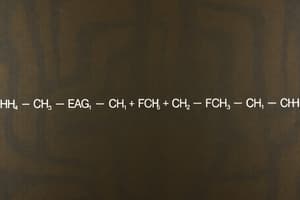Podcast
Questions and Answers
Which of the following is an example of a local drug reaction in the oral cavity?
Which of the following is an example of a local drug reaction in the oral cavity?
- Chemical irritation from an aspirin tablet (correct)
- Erythema multiforme
- Depression of bone marrow function
- Gingival hyperplasia
Prolonged use of antibiotics can lead to which opportunistic infection in the oral cavity?
Prolonged use of antibiotics can lead to which opportunistic infection in the oral cavity?
- Aphthous stomatitis
- Toxic epidermal necrolysis
- Lichenoid drug reaction
- Candidiasis (thrush) (correct)
Which of the following oral conditions can result from folate deficiency caused by prolonged phenytoin use?
Which of the following oral conditions can result from folate deficiency caused by prolonged phenytoin use?
- Gingival hyperplasia
- Lichenoid drug reaction
- Aphthous stomatitis (correct)
- Toxic epidermal necrolysis
Agranulocytosis, characterized by necrotizing ulceration of the gingivae and throat, is associated with the depression of which of the following?
Agranulocytosis, characterized by necrotizing ulceration of the gingivae and throat, is associated with the depression of which of the following?
Which medication is LEAST likely to cause a Lichenoid drug reaction?
Which medication is LEAST likely to cause a Lichenoid drug reaction?
Erythema multiforme and Stevens-Johnson syndrome have been associated with which of the following medications?
Erythema multiforme and Stevens-Johnson syndrome have been associated with which of the following medications?
Toxic epidermal necrolysis is considered an extreme form of which other drug reaction?
Toxic epidermal necrolysis is considered an extreme form of which other drug reaction?
Which medication, used to treat gout, has been implicated in causing toxic epidermal necrolysis?
Which medication, used to treat gout, has been implicated in causing toxic epidermal necrolysis?
Which of the following is a characteristic feature of fixed drug eruptions?
Which of the following is a characteristic feature of fixed drug eruptions?
Which class of drugs is associated with causing gingival hyperplasia?
Which class of drugs is associated with causing gingival hyperplasia?
Which heavy metal can cause black or brown deposits in the gingival margins?
Which heavy metal can cause black or brown deposits in the gingival margins?
Which of the following drugs can cause a blue line in the gingival margin?
Which of the following drugs can cause a blue line in the gingival margin?
Excessive use of which antiseptic can cause extrinsic yellow or brownish-dark pigmentation of the teeth and oral mucosa?
Excessive use of which antiseptic can cause extrinsic yellow or brownish-dark pigmentation of the teeth and oral mucosa?
Dry mouth is a relatively common side effect of drugs with which type of action?
Dry mouth is a relatively common side effect of drugs with which type of action?
Which of the following drug is least likely to cause depression of bone marrow function?
Which of the following drug is least likely to cause depression of bone marrow function?
Which of the following is characterized by severe spontaneous gingival bleeding?
Which of the following is characterized by severe spontaneous gingival bleeding?
Grinspan's syndrome is associated with which of the following conditions?
Grinspan's syndrome is associated with which of the following conditions?
Immunosuppression from medications like corticosteroids can lead to which oral health concern?
Immunosuppression from medications like corticosteroids can lead to which oral health concern?
Which of the following is a common oral disease that can be difficult to distinguish from a drug reaction?
Which of the following is a common oral disease that can be difficult to distinguish from a drug reaction?
What information is MOST essential for diagnosing drug-related oral reactions?
What information is MOST essential for diagnosing drug-related oral reactions?
Flashcards
Chemical Irritation (Burn)
Chemical Irritation (Burn)
Irritation caused by a substance directly contacting the oral mucosa, like holding an aspirin tablet against a toothache.
Interference with Oral Flora
Interference with Oral Flora
Alteration of the mouth's normal microbial balance, often by killing sensitive organisms and allowing resistant ones to thrive. This can lead to conditions like thrush.
Anemia caused by drugs
Anemia caused by drugs
A condition where the body produces fewer red blood cells, potentially leading to oral signs.
Aphthous Stomatitis from Phenytoin
Aphthous Stomatitis from Phenytoin
Signup and view all the flashcards
Agranulocytosis
Agranulocytosis
Signup and view all the flashcards
Lichenoid Drug Reactions
Lichenoid Drug Reactions
Signup and view all the flashcards
Toxic Epidermal Necrolysis (TEN)
Toxic Epidermal Necrolysis (TEN)
Signup and view all the flashcards
Fixed Drug Eruptions
Fixed Drug Eruptions
Signup and view all the flashcards
Gingival Hyperplasia (drug-induced)
Gingival Hyperplasia (drug-induced)
Signup and view all the flashcards
Oral Pigmentation (drug-induced)
Oral Pigmentation (drug-induced)
Signup and view all the flashcards
Dry Mouth (drug-induced)
Dry Mouth (drug-induced)
Signup and view all the flashcards
Study Notes
- Reactions to drugs are classified into local reactions, systematically mediated reactions, and other effects.
Local Reactions to Drugs
- Chemical irritation and interference with the oral flora are local drug reactions.
- Chemical irritation can happen when an Aspirin tablet is held against the mucosa near a tooth that aches.
- A white patch that has superficial necrosis and shedding of dead epithelium can occur.
- The mucosa heals after removing the cause of the chemical irritation.
- Other chemicals like acid etchants, Phenol, CMCP, and NaOCl can cause irritation if accidentally dropped on the mucosa, especially without proper isolation.
- Prolonged use of antibiotics can alter the normal oral flora by killing sensitive organisms, leaving resistant ones.
- Candida albicans can proliferate, resulting in thrush or acute atrophic candidiasis.
- Topical steroids can have adverse effects on the immune response locally when used for a long time or in large doses, or systemically due to absorption.
Systemically Mediated Reactions
- Depression of bone marrow function, depression of cell-mediated immunity, lichenoid drug reaction, erythema multiforme, toxic epidermal necrolysis, and fixed drug eruptions are systematically mediated reactions.
- Some medications can cause anemia, which can cause oral signs, few drugs significantly depress RBCs production alone.
- Prolonged use of Phenytoin can cause Foliate Deficiency and Macrocytic Anemia in susceptible patients.
- Severe Aphthous Stomatitis like ulcers can be caused by Foliate Deficiency and Macrocytic Anemia, administration of Foliate can resolve the Aphthous Stomatitis.
- A variety of drugs can depress WBCs production.
- Agranulocytosis, with necrotizing ulceration of the gingivae and throat, can be the clinical picture of WBCs production depression.
- Untreated Agranulocytosis can lead to severe illness and Septicemia.
- Drugs that may cause WBCs production depression include antibacterials, analgesics, antipsychotics, and antithyroid agents.
- Low-grade oral pathogens can produce necrotizing ulceration (such as NUG) when the effect is on Granulocytes.
- Drug-induced purpura can be an early sign of Aplastic Anemia from medications that depress marrow function such as Chloramphenicol.
- Drug-induced purpura can cause severe spontaneous gingival bleeding, blood blisters, and submucosal ecchymosis.
- Aspirin affects platelets, can cause oral purpura.
- Immunosuppression by drugs like Corticosteroids is induced in patients with organ transplants or immunologically mediated diseases, who receive high doses of corticosteroids for prolonged time.
- Viral and fungal infections of the mouth are common and can be severe in immunosuppressed patients.
- Recurrences of childhood viral infections such as Recurrent Herpes, Measles, and Chickenpox are possible.
- Gold Salts, antimalarials, antihypertensive agents like Methyldopa and Captopril can cause lichenoid drug reactions, meaning lesions indistinguishable from Lichen planus clinically and histologically.
- Grinspan's syndrome includes hypertension, diabetes mellitus, and Lichen planus.
- Erythema multiforme & Stevens-Johnson syndrome may be caused by Penicillin, Sulphonamides, NSAIDS, Anticonvulsants, Barbiturates.
- Toxic epidermal necrolysis is the extreme end of the spectrum of Erythema multiforme, which is one of the most dangerous and severe types of drug reactions.
- Mucosal involvement is common and causes widespread erosions due to epithelial destructions in Toxic epidermal necrolysis.
- Early diagnosis and treatment are important (Lifesaving) as Toxic epidermal necrolysis reaction can be lethal.
- Toxic epidermal necrolysis (TEN) may occur along with Stevens–Johnson syndrome (SJS).
- Drugs implicated in Toxic epidermal necrolysis include Sulfonamides, Beta-lactams, NSAIDs, Allopurinol, Antimetabolites, Antiretroviral drugs, Anxiolytics, and Anticonvulsants.
- Sharply circumscribed skin lesions (mostly painful purple patches) recurring at the same site each time the drug is given are fixed drug eruptions.
- Cotrimoxazole, Trimethoprim, Tetracycline, Doxycycline, Ciprofloxacin, Clarithromycin, Fluconazole, NSAIDs, Phenytoin, Pseudoephedrine, and Phenolphthalein can cause fixed drug eruptions.
- Involvement of the oral mucous membrane is exceedingly rare in fixed drug eruptions.
Other Drug Effects
- Gingival hyperplasia, oral pigmentation, and dry mouth are other drug effects.
- Anticonvulsants, antihypertensive agents including ACE inhibitors and Calcium channel blockers, and Immunosuppressant medications can cause fibrous hyperplasia of the gingivae particularly concentrated at the interdental papillae.
- Heavy metals such as Mercury, Bismuth and Lead can cause black or brown deposits in the gingival margins by the interaction with bacterial byproducts to form metal Sulfides.
- The blue Lead line indicates the level of the floor of the pocket.
- Mercury and Bismuth are no longer used in medicine and Lead is no longer a major industrial hazard, thus the effects of the heavy metals are rarely seen nowadays.
- Cisplatin, a cytotoxic drug, can cause a blue line.
- Topical antibiotics & antiseptics may cause dark pigmentation, particularly of the dorsum of the tongue, due to over growth of the pigment forming bacteria.
- Excessive use of Chlorhexidine can cause extrinsic yellow or brownish-dark pigmentation of the teeth, oral mucosa and dorsal surface of the tongue.
- Dry mouth is a relatively common side effect of some drugs, particularly those with an Anticholinergic or Atropine like action, such as the Tricyclic antidepressants, MAO inhibitors, Phenothiazine antipsychotics, and Antihistamines.
Management Considerations
- History is the key for diagnosis.
- Oral reactions to drugs are not overall common; nevertheless, they may be important as an early sign of a dangerous or lethal reaction.
- A drug being taken by a patient is not necessarily the cause of any oral symptom.
- Coincidence is often difficult to exclude, particularly with common oral disease such as Lichen planus.
- The problem is made more difficult by multiple drugs treatment.
- A detailed history of medications is essential as it may affect other aspects of dental treatment.
Studying That Suits You
Use AI to generate personalized quizzes and flashcards to suit your learning preferences.




